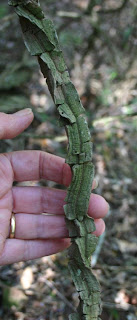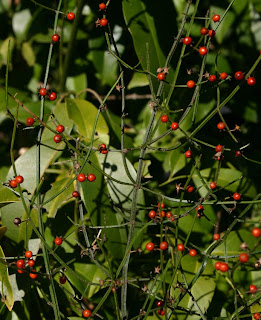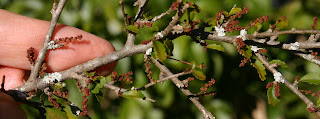The closest I could get to identifying it myself was the thought that it might be the "Lobed Silkpod", Parsonsia leichhardtii. However none of the sources I checked mentioned that this species might have the remarkably attractive, deeply furrowed corky stem of our Franke's Scrub plant.

 It also had no sign of the purple-backed leaf which I believed was a characteristic of the species (though I had an idea that it did not occur on examples from all areas).
It also had no sign of the purple-backed leaf which I believed was a characteristic of the species (though I had an idea that it did not occur on examples from all areas).I went back to the scrub to get photographs and some fresh flower samples, and was fortunate enough to find some of last season's seed capsules still on the plant together with a few seeds, with their silky plumes. All these things help with identification.
I was delighted when friends Phil and Cheryl offered to call in at the herbarium on a trip to Brisbane this week, and deliver the specimens with the flowers still fresh and uncrushed. It created some interest there, apparently.
The botanists decided that it was indeed P. leichhardtii, but said that they had never before come across an example with corky bark on the stem, like our specimen. (the first photo is of the stem at ground level, and the second at about 2m from the ground.)
So we can feel pleased that we have something else special and unusual in our favourite patch of scrub.
[contributed by Trish]









